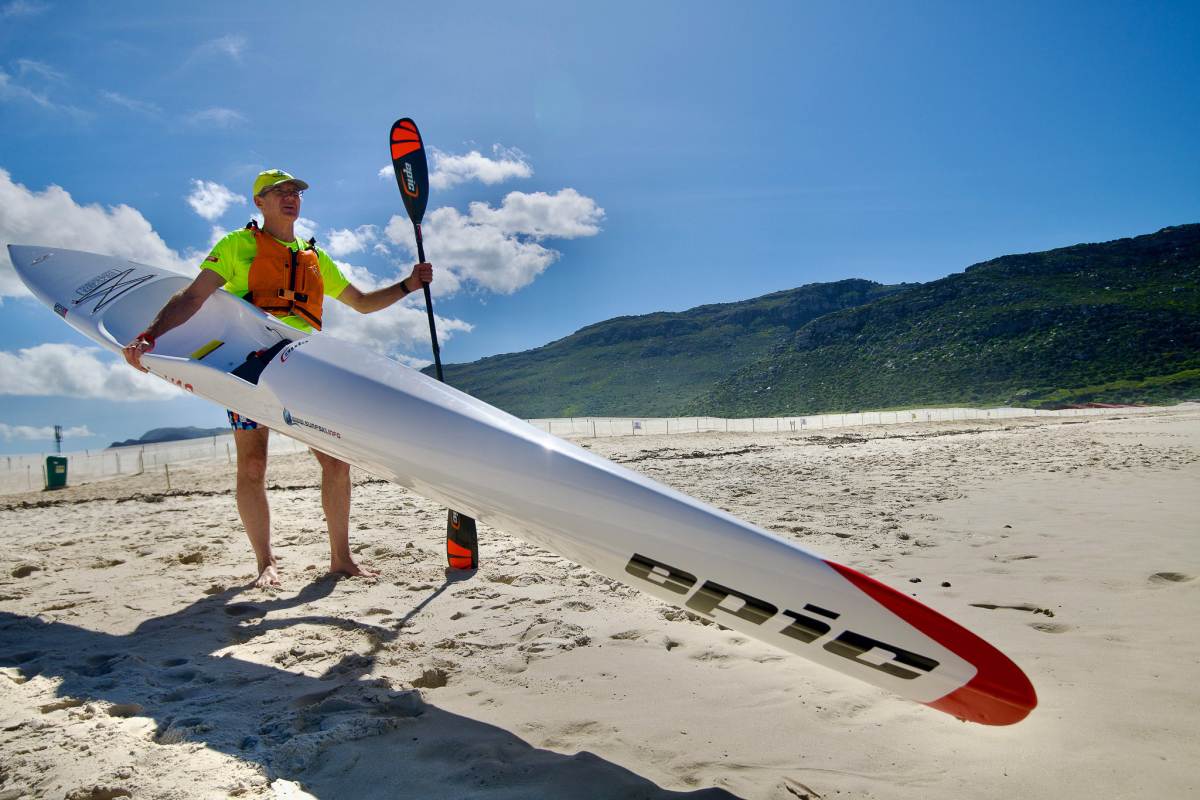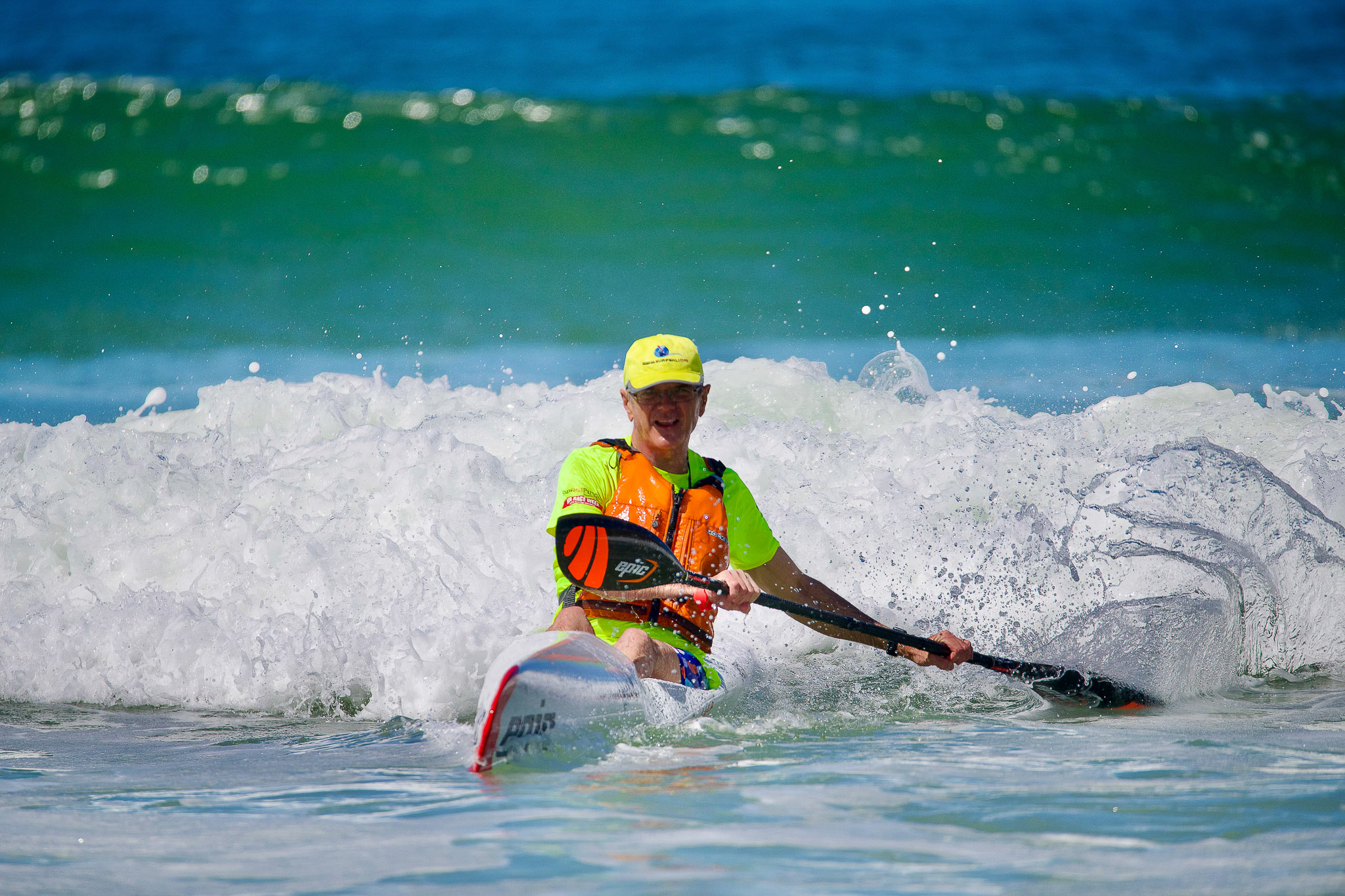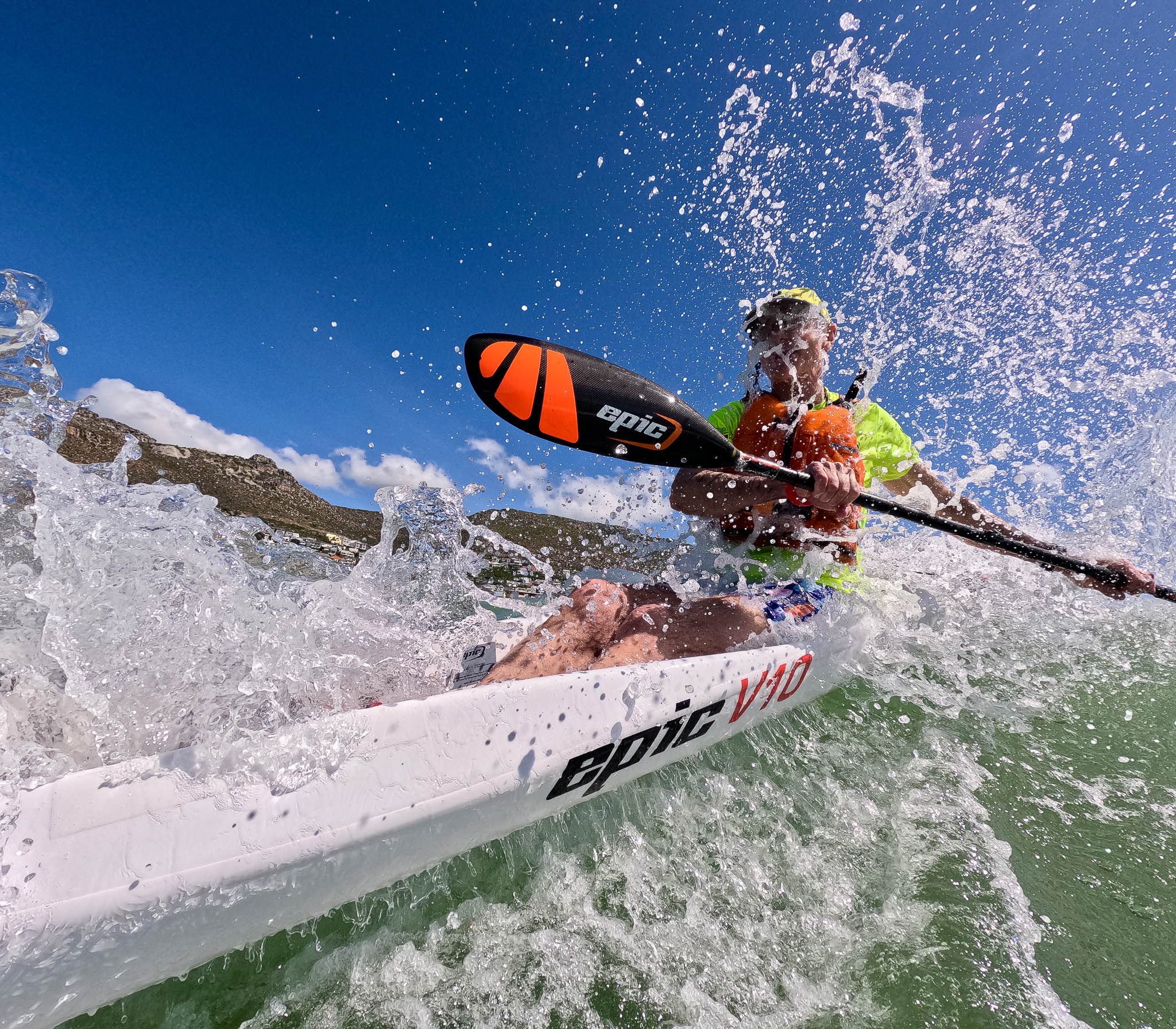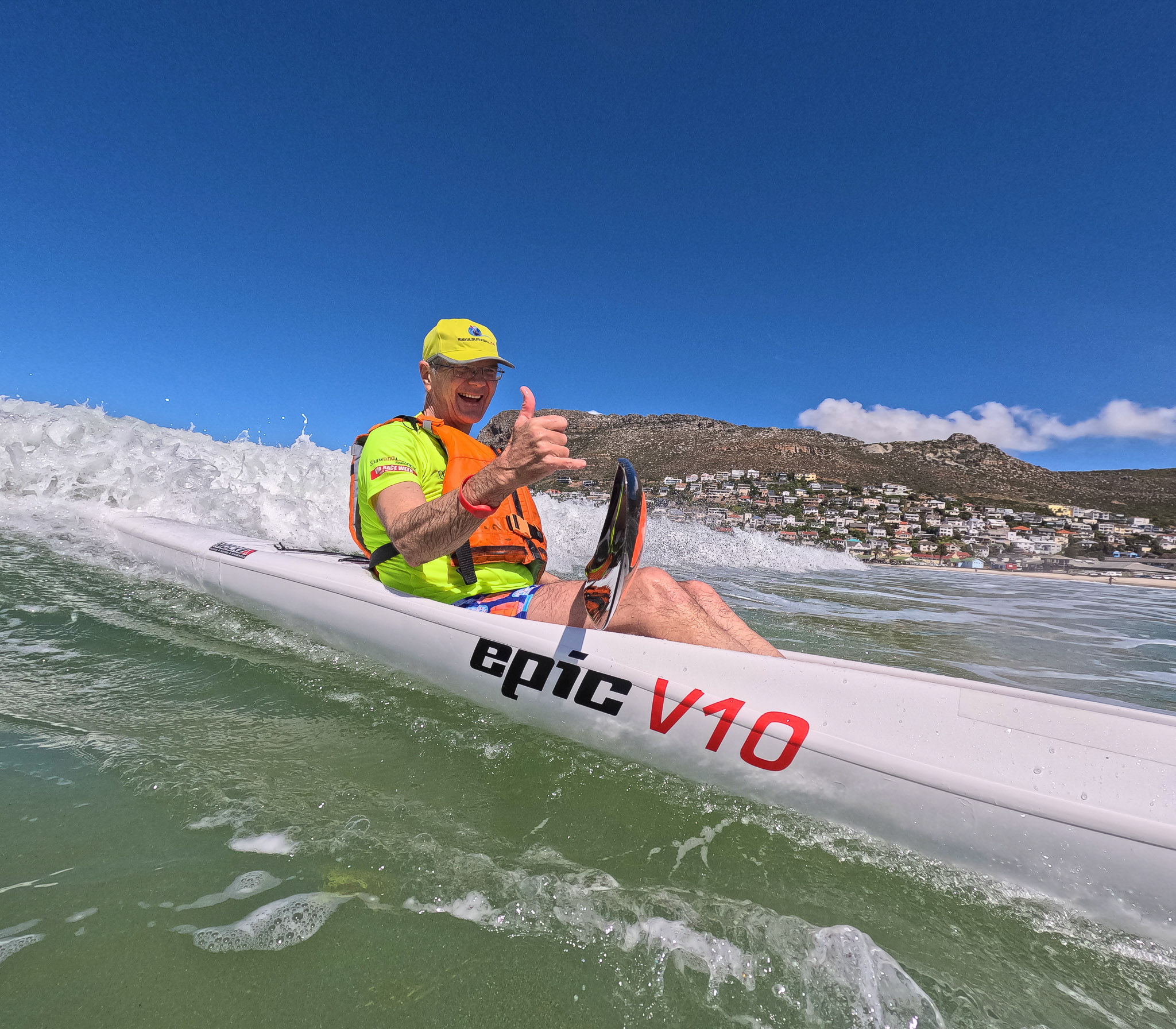Epic V10 4G Surfski Review: The Ultimate Intermediate Surfski?

“What the bloody hell are you doing here?” I thought to myself a few moments after launching on the brand new V10 4G for the first time. It was getting dark; it was raining; the squalls were lifting sheets of spray off the water… directly offshore. What WAS I thinking?
The answer is that I’m a sucker for new toys – and if I get my hands on one, I HAVE to play with it. Damn the weather, full speed ahead…
Since then I’ve paddled the boat many more times, in much pleasanter weather. Here’s what I think of this, the latest in Epic Kayak’s lineup of surfskis.
First Impressions
It was difficult of course to judge the boat on that first paddle; besides the “oh-my-hat-I’d-better-not-lose-it” thoughts, I was too focused on surviving the conditions. But two things were clear: my coccyx was compatible with the seat (hooray!) and the ski was very stable. As I made my way along to the coast, hugging the shoreline, side-on to the gusts, whatever else I was feeling, I wasn’t afraid of falling out.
The next day, when the weather had calmed down, I was able to spend some time examining the boat itself.
Firstly, the build quality is truly extraordinary. Epic Kayaks have been building surfskis since 2005 and have well-deserved reputation for the excellence of their boats’ strength and appearance. The hull is rock-hard, the seams are dead straight, the gel-coat wrinkle free.
The footplate, the well tried and tested tiller bar assembly, the rudder pedals and the rudder itself all scream “quality”.

Comfort and Stability – the cockpit
My coccyx is notoriously challenged when it comes to surfski seats: I found my old and beloved Fenn Swordfish S seat so uncomfortable that I had to install a bum pad to stop my backside being rubbed raw; older generations of the V10 had the same issue for me (although to be fair, I seem to be in the minority – most of my buddies don’t suffer the same defect!). In any case, I’m delighted to report that this update of the V10 is compatible with my backside – the seat is one of the most comfortable I’ve ever used.
(Just a side note: I didn’t appreciate just how important comfort is until I paddled the Carbonology Zest X. I had owned an earlier version and was extremely familiar with it. I found the X model to be a significant improvement, but couldn’t figure out whether it had more rocker, less volume or why it handled so much better. The answer – from an amused designer – was simply that the seat had been redesigned. Better comfort; better performance.)
The rails on the V10 4G are low (over 1cm lower than the Swordfish’s for example) and that contributes to the ease of remounting – which I experienced firsthand at the start of a race when I was the only one not to make it over the last wave of an incoming set…
Hull strength
Of course, it’s difficult to assess the strength of any hull until you break it!
But not making it over the last wave of the set described above, was only the beginning… it took me another five minutes, multiple poundings by the next set and another swim finally to get out beyond the break to start my race. The rest of the field had disappeared out of the bay, and I nearly made an expletive-laced quitting decision. (I didn’t and managed to catch the back markers by the half-way mark, and finished happy that I hadn’t come last.)
But here’s the thing: I was very aware that the spectators knew that I was on a brand-new boat. They were delighted by the first wave, which provoked raucous laughter and “helpful” comments – but they became quieter and quieter as my struggle continued. Both they and I were genuinely concerned that the boat might have sustained damage.
Happily, not even a scratch; I was most concerned about the rudder, having been violently thrown backwards by the breakers, but it was undamaged.

My boat is the “Ultra” layup (11.9kg) – which features a composite skin made of Kevlar fabric, carbon fiber and fiber glass, vacuum bagged over a Nomex honeycomb core and coated with heat-cured epoxy. The result is a rock-hard and seemingly durable hull. No soft spots here.
The “Elite” layup boat (10.6kg) uses the same core but is skinned with 3k carbon fiber.
The boats are listed on the Epic website at $4,695 and $5,295 respectively.
What’s Different about the 4G?
Each iteration of the V10 has led to increased stability – and I find this one phenomenally stable. At my advanced age (60), stability is becoming increasingly important. I feel pretty much bullet-proof in my old Swordfish S – and the same is true of the V10 4G.
The 4G has been given slightly more rocker than its predecessors, but the biggest change, perhaps, is that it’s been given a nose similar to the distinctive shape of the V12 3G: finer, less volume. More on that later.
Epic themselves say that the boat is designed for downwind paddling, the rocker and nose giving “the best downwind performance yet of the V10 series”.
What’s it like to paddle?
One of the joys of Cape Town is that we can paddle the whole year round. In summer the prevailing southeaster powers our famous/notorious Miller’s Run; in winter cold fronts bring northwesters and we simply go the other way. The “Reverse Miller’s” tends to have smaller, cleaner conditions, the conventional Miller’s can vary dramatically – but usually offers bigger, sometimes confused seas.
Suffice to say that I've paddled the V10 in a wide variety of conditions, downwind, upwind and on the flat.
Is it slow on the flat?
You might expect the 4G to be slow – after all it has “increased rocker” plus it’s an “intermediate” boat with the stability associated with greater hull width and consequently, drag, than its slimmer brethren.
What didn’t help was that when the boat arrived, I’d just come out of a series of fitness challenges – injury, covid and surgery – and I wasn’t back to my A-game.
But suffice to say that as the weeks went on, I went from being at the back of our training squad to holding my own with my peer group, even raising some eyebrows during squad sprint intervals.
My conclusion is that the extra width probably does affect the boat – but only in comparison the V12s/V14s of this world and not at the speeds that I paddle at. During those sprints, I was sustaining 11.7-11.9kph, surging onto tiny bumps on the water’s surface. For me, that’s a decent speed. (In any case I regard flat water paddling as a necessary pain – and mere training for downwind.)
And Downwind...
This is a fascinating boat in downwind conditions. I haven't fully mastered its nuances, but I’m getting to grips with it enough to appreciate its potential.
In comparison with other boats, it seems to accelerate onto the runs a moment or two later and I’m beginning to get to understand the timing required. If you start paddling too soon, you’re wasting effort; get it right and instead of fighting the boat, you’re guiding it – and man, when you do get it right, it’s an awesome feeling.
So much for getting onto the runs; the V10 4G will then sit happily on the crest (if conditions are not too confused), but the magic happens when you accelerate down and over the next run; that slim nose seems to slice through the next wave without the boat decelerating – a little more grunt and you’re up and over the next wave, and the next, and the next.
It’s almost as if this boat has two modes: the tick-the-box easy-to-use stable, fun downwind mode – but also the promise of elite-level capability if you have the skill and strength to drive it.
(I must caveat this by admitting to a tendency to new-boat-enthusiasm, but I think I’ve been paddling this boat long enough now that I should be past this phase.)
Other characteristics: although it’s astoundingly responsive to the classic big elliptical rudder first introduced to surfskis by Epic in 2005, it also holds a straight line beautifully – the reason, to me, for having an effective rudder in the first place. Often on our downwind runs, the wind doesn’t line up perfectly and we find ourselves surfing diagonally down the faces of the runs. I’ve paddled some boats with a horrific tendency to spin out; the V10 is not one of them.
(My one frustration, and I'm pretty sure it's my skill - or lack thereof - letting me down, is when the sea is short and confused. We sometimes get sections on a Miller's Run where reflected waves cause intense confused chop. I feel that I should be able to power through the chop on the overall swell, but I can't get it right. It's not lack of stability, it's more that I'm not timing my stroke right to get boat speed up and onto the runs. I'm working on it.)
Cockpit Drainage
Although I’ve put a wave deflector in front of the cockpit, the boat is not particularly wet, despite the relatively low rails.
Water does get in, of course – but the baler drains the cockpit very rapidly with a satisfying sucking/gurgling sound when it empties.
The elite paddlers say they keep the baler closed to minimize drag and only open it when necessary to drain the footwell. I’m not sure that’s strictly necessary – when it's rough I just leave it open; on the flat I keep it closed and kick it open if I need to.
Leash Anchor
I inadvertently tested the strength of the leash anchor point and simultaneously proved the surfski axiom, “he who hesitates at the backline will get taken out”, at the end of one of the Miller’s Runs.
Having forgotten (rookie error) to undo my leash, I found myself half-drowning, being dragged behind the boat as the surf dragged it inshore. The leash was straightened but didn’t break (impressive, Mocke Paddling!) nor did the boat suffer any damage.
Negatives
We found some minor issues: The rubber cover over the baler lever wasn’t very secure – during a Miller’s Run, I kicked it off the lever. Happily, I managed to grab it before it went overboard and have glued it back on more thoroughly.
A friend pointed out the small plastic spacers that had come off the bottom of his footplate; again, they just need to be attached more securely.
As noted above, in extreme choppy conditions, I'm struggling to get the boat to accelerate onto the runs, but I'm pretty sure it's a timing issue on my part.

Conclusion
Epic claims that with the 4G, they’ve created a “unique, nimble boat for advanced/intermediate skilled paddlers that doesn’t require elite level stability skills” and it’s hard to disagree.
Full disclosure: Epic have said that I can hang on to this boat for as long as I want to paddle it; I don’t think it’s going back to them anytime soon.
I have two goals for 2024 in the V10 4G: paddle my 1,000th Miller’s run and break my Miller’s Run Personal Best time. Assuming I don’t injure myself, the 1,000th run will happen sometime in the second half of next year; beating my PB (43:10, average speed 16.3kph over 11.7km) set in 2020 is scheduled for January/February, when the southeasters seem to blow at the optimal strength and direction.
In the meantime, I’m loving the challenges of getting fit again and learning to get the best out of this downwind beast of a surfski.

